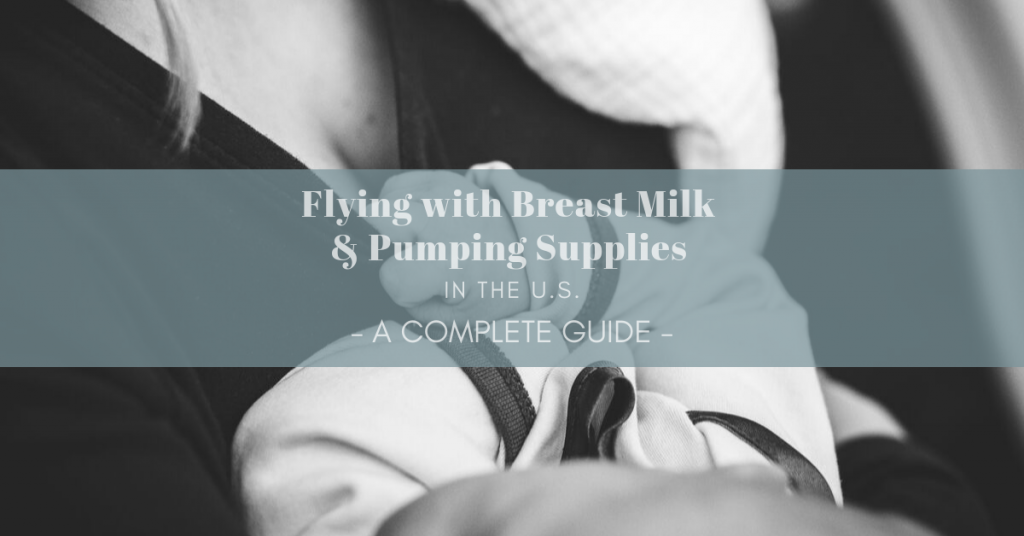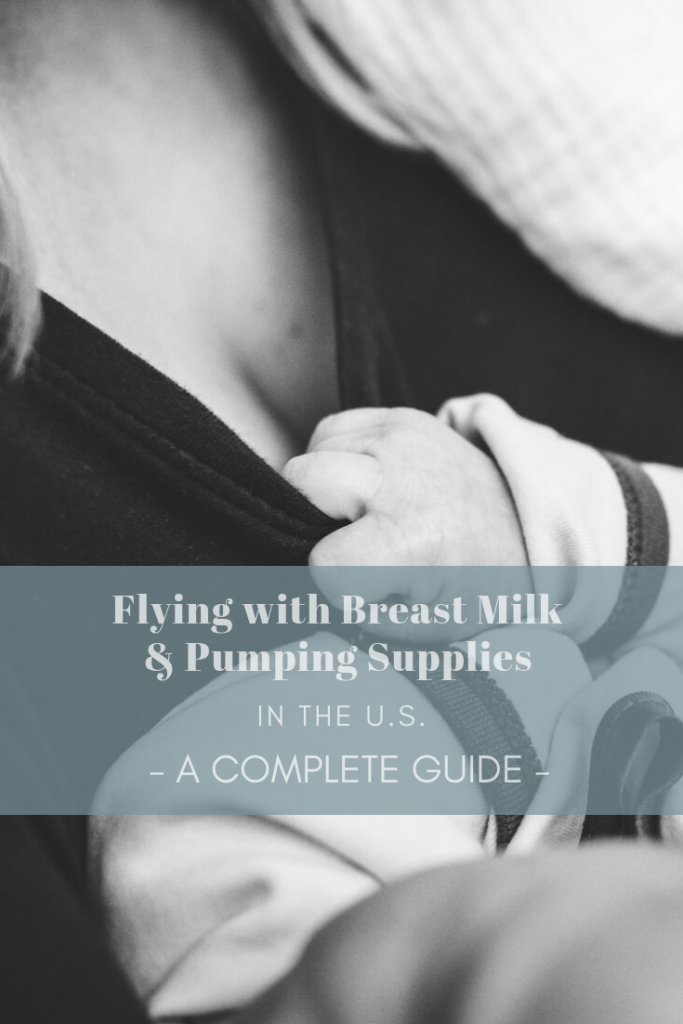 If you are reading this post, I’m assuming you are a mother who is planning a trip on an airplane, with or without your baby, and you plan on pumping and carrying breast milk while you are away from home. There is a lot that goes into traveling with breast milk and pumping away from home, and it can be daunting. I remember doing many hours of research trying to put together the pieces on how to prepare. I thought I’d put together a guide that can help you know exactly what you should expect when making your way to an airport with a bag full of breast milk and pumping supplies.
If you are reading this post, I’m assuming you are a mother who is planning a trip on an airplane, with or without your baby, and you plan on pumping and carrying breast milk while you are away from home. There is a lot that goes into traveling with breast milk and pumping away from home, and it can be daunting. I remember doing many hours of research trying to put together the pieces on how to prepare. I thought I’d put together a guide that can help you know exactly what you should expect when making your way to an airport with a bag full of breast milk and pumping supplies.
Let me start by giving you a brief background of my breastfeeding story with my son (now 16 months old). From the beginning, it was a struggle. At first, it was very painful, but even after the pain faded, it was extremely time-intensive. Carson took over an hour and a half, sometimes longer, for every feeding session, even in the middle of the night. We quickly learned that Carson was having trouble getting enough milk which translated into the very long feeding sessions. Carson was losing weight, and I wasn’t able to pump enough in between breastfeeding sessions, so after many lactation consultations, ENT appointments, and some feeding therapy appointments, we knew we needed to start supplementing with formula. Even though we were supplementing, I continued to try to breastfeed until Carson was around four months old. At that time, I made the decision to stop breastfeeding in the traditional way and to start breastfeeding via pumping as much as I could. Thus began my journey of needing to travel with breast milk whether or not I had Carson with me on the journey.
Here is a compilation of everything you need to know for carrying breast milk and pumping supplies on a U.S. flight based on my experience as a traveling, full-time pumping mama.
Preparation
- Breast milk is exempt from the normal TSA rules regarding liquids – it is not limited to the 3.4 ounces that other liquids are limited to. You can carry it in bottles and/or milk bags. Since I primarily pumped with the Willow wearable breast pump on my trips, I always had my milk in milk bags.
- Your breast pump generally does not count as a carry-on item because it is considered a medical device per the FDA. However, I have heard that there may be some variations on these rules as enforced by individual airlines, so contact your airline before the trip. Once you verify the rules with your airline, if you have a traditional pump, I recommend carrying your pump and supplies in their own bag for easy access, cleanliness, and space. There are many pump bags out there in different price ranges. I never owned one because by the time I flew with a pump for the first time, I had the Willow pump, which is easily able to fit in any carry-on bag without sacrificing space or cleanliness.
- A breast milk cooler (discussed in the next bullet point) does count against your carry-on item limits.
- You will want a cooler for breast milk if you plan on keeping the milk on hand for over 4 hours (the recommended limit for keeping breast milk at room temperature). So, this is likely necessary if you are traveling without baby or if your baby isn’t going to drink the milk within 4 hours. The travel cooler I purchased for breast milk is no longer available, but it’s very similar to this one, and I also purchased these CoolerShock Freeze Packs. Both of those items together worked really well for me. [These two links are Amazon Affiliate links.]
- Freezer packs for your breast milk cooler are allowed through TSA as well.
- Your life will be much easier if you are able to keep your breast milk frozen before going through security. TSA does not need to open or test frozen breast milk at all. If you are staying in a hotel, Airbnb, or somewhere else you may not know will have a freezer, contact them ahead of your trip to ask, and if they do not have one in your room, ask if they will take your breast milk and put it in the kitchen freezer for you. I have had several instances where I needed to send my contained, labeled breast milk to a hotel kitchen freezer, and it has never been a problem.
- You do not need to be traveling with a baby to qualify for the special rules regarding breast milk. I have heard stories of other mothers having a difficult time getting their breast milk through security without their baby, but I never have. Just in case though, I always mentally prepare myself to stand my ground and pull up the TSA’s own website to show that I should be let through with my breast milk.
- Remember that you will need on-the-go cleaning supplies for your pumps if you don’t have spare parts and are pumping more than once before arriving at your destination. A quick wipe of your parts may be fine if you aren’t using them again before arrival, but it won’t clean out all the little milk drops in your pump. You will want a small bottle of a pump cleaner of sorts (I think baby soap is sufficient), access to a sink with warm water, and a clean cloth for drying.
Getting Through Airport Security
So, you’ve made it to the airport, you’ve checked in and gone through baggage check, and you are getting in line at security, boarding pass and ID in hand. Whew! That’s already a major feat whether you are traveling with baby or just your regular luggage plus pumping and milk storage supplies. Here is what to expect as you make your way through security:
- After you place your cooler or bags down on the conveyor belts, try to get a TSA agent’s attention to let them know you have breast milk in your bag. I’m not always able to get their attention, but it’s never been an issue for me since I let them know as soon as they pull my bag for screening.
- Once they’ve pulled your bag for screening, be prepared for them to completely unpack the bag containing the liquids. This can be very frustrating. I’ve had some agents just pull out one container of milk, take a look, and then put it back. But I’ve also had others completely pull out all my “perfectly” packed and organized items only to stuff them all back in at the end. Keeping a separate bag or cooler for liquids can help prevent this.
- If your breast milk is not frozen, or if the TSA agent determines that your frozen milk has thawed too much, then they may want to test it. You have the right to tell the agent you do not want the breast milk opened or X-rayed – they can use alternative screening procedures that are less invasive to clear the milk for flying.
- If you choose to allow non-frozen breast milk to be tested, it is perfectly fine for you to ask the agent to change into clean gloves and to pour a small amount of the milk into a separate container for testing.
Pumping in the Airport & On the Plane
Once you’ve cleared security, you really have nothing else to be concerned about regarding TSA rules for carrying breast milk and a pump on the plane, other than letting the gate agents know you are carrying a medical device should you be questioned for having too many carry-on items.
At the Airport
Many airports today offer mothers’ rooms intended for breastfeeding or pumping. I found this handy website that allows you to search airports and find their breastfeeding locations (or lack of them). If there isn’t a mothers’ room, you can pump in a family restroom, women’s restroom, or even at the gate if necessary. Just be sure your pump is fully charged before your trip in case you aren’t able to find a working outlet wherever you end up pumping.
On the Plane
You are allowed to pump at your seat or in the lavatory on an airplane. As I do not have experience in either of these scenarios with a traditional breast pump, my advice will not apply to all here. Since I owned my Willow pump by the time I first flew after giving birth, it was really easy for me to cover up with my nursing cover and slip in the pumps (that I had already prepared with clean milk bags). The Willow pump also cannot be heard over the white noise of the airplane which is a plus. Before I decided to buy the Willow pump, I had planned to bring my traditional pump and do my pumping session at the airport before my flight, and then again immediately after landing, rather than having to use the pump in my seat or airplane lavatory.
Based on my experience, that is everything you need to know about flying with breast milk and pumping while traveling by plane! Let me know if you have any additional tips or stories to share in the comments below. I know everyone has different experiences and knowledge to contribute.
{Thanks for reading! Want to know a little more about me? I’m a CPA learning how to balance a career with motherhood and regular travel while planting roots at home in the Austin, TX area. When I’m not exploring my home city with my husband Daniel and baby boy Carson or cuddling with my chubby orange cat Banana, I’m probably either out on a playdate with my son or planning, packing for, traveling to, or daydreaming about our next adventure. After all, my travel mug collection is never complete. If you have wanderlust too, be sure to follow me on Instagram (and InstaStories!), Pinterest, and Facebook, or subscribe to my blog!}
